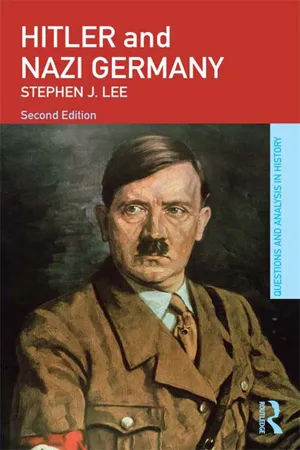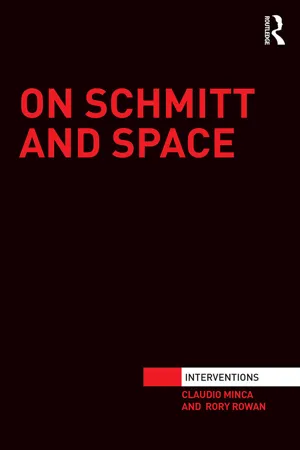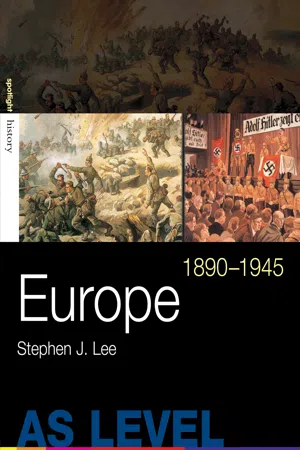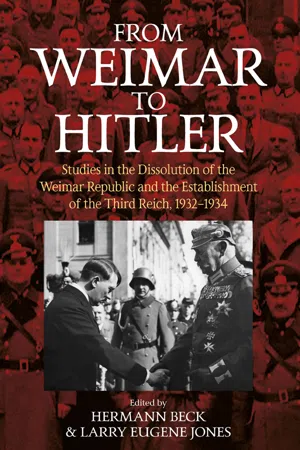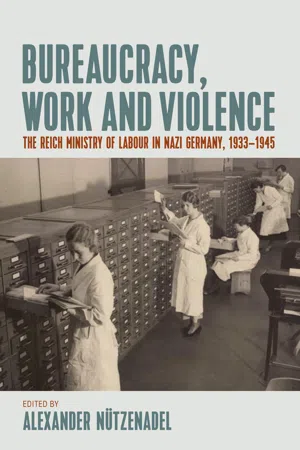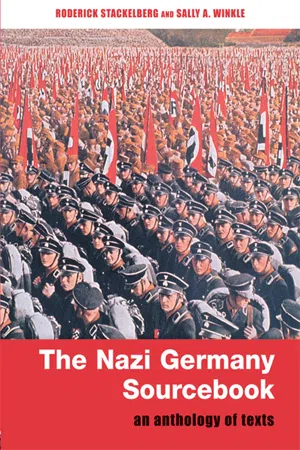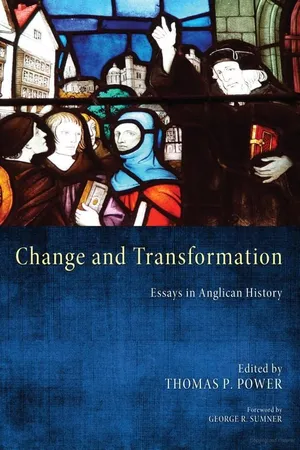History
Enabling Act
The Enabling Act was a law passed by the German Reichstag in 1933, which gave Chancellor Adolf Hitler the power to enact laws without the involvement of the Reichstag or the President. This effectively allowed Hitler to establish a dictatorship and consolidate his control over Germany. The Enabling Act marked a significant turning point in the rise of Nazi power and the erosion of democratic institutions in Germany.
Written by Perlego with AI-assistance
Related key terms
10 Key excerpts on "Enabling Act"
- eBook - ePub
- Stephen J. Lee(Author)
- 2013(Publication Date)
- Routledge(Publisher)
Machtergreifung. Hitler, clearly, did not seize power. However, the rapid progress of events which began with Hitler’s appointment and ended on 2 August 1934 with the union of the offices of president and chancellor in the person of ‘the Führer and Reich Chancellor Adolf Hitler’ did amount to a seizure of complete power. In quick succession, Hitler and his fellow Nazi leaders implemented radical policies in order to make Germany’s government their own, thus turning democracy into dictatorship.Source 2.4: H.W. Koch on Hitler’s Enabling Act (from Aspects of the Third Reich, published in 1985)
Enabling laws, by which Parliament gives the government the right to legislate for a period of time, were nothing new in Germany’s constitutional history. After the outbreak of the First World War the Reichstag had enabled the Bundesrat to legislate in the economic sphere for the duration of the war. The first great coalition under Stresemann as well as his successor passed Enabling Laws on 13 October and on 8 December 1923, to stabilise Germany economically, that is to end inflation. In practice all presidential cabinets between 1930 and 1932 acted on the basis of enabling laws, that is, emergency decrees. While in 1930 a total of 98 laws were enacted, in 1931 the number of laws had been reduced to 34 compared with 42 emergency decrees. In 1932, 5 laws were passed, and 60 emergency decrees enacted. Hitler had made an Enabling Law one of the conditions of his chancellorship.Source 2.5: K.D. Bracher’s views on the term ‘legal revolution’ (from The German Dictatorship, first published in English in 1970)
The slogan of legal revolution offers the key to the character and development of the National Socialist power seizure. National Socialist propagandists, politicians, and constitutional experts all along emphasized that although Hitler’s takeover was the beginning of a revolution that would profoundly affect all aspects of life, it was a completely legal, constitutional process. The paradoxical concept of a ‘legal revolution’ artificially linked two contradictory axioms of political action and behaviour. The significance of this legality tactic with revolutionary aspirations was in fact more than a mere propaganda gimmick and should not be underestimated. In examining specific components of the political process, we find that this tactic played a decisive role in surrounding this new type of totalitarian power seizure with its seductive aura of effectiveness and made all legal, political, or even intellectual resistance so difficult, and, in the opinion of many, well-nigh impossible. - eBook - ePub
- Claudio Minca, Rory Rowan(Authors)
- 2015(Publication Date)
- Routledge(Publisher)
This was a largely powerless institution – set up by Hermann Göring ‘to affect a fake marriage of Prussian tradition and Nazi Revolution’ (Müller, 2003 : 37) – for which Hitler showed clear disregard but which Schmitt, even in later life, considered a great honour. He returned the favour to his new masters by voicing his support for the Enabling Laws, an amendment to the Weimar Constitution granting the executive arm of government (meaning Hitler and the Party) the power to enact laws without the involvement of the Reichstag. This move effectively dissolved the division of power between executive and legislative branches of government that lay at the basis of the German Republic's constitutional arrangements, making room for the direct implementation of Nazi policy measures with the force of law, while the Constitution remained as an empty husk. The Enabling Act de facto ‘enabled’ Hitler with unlimited power and gave him uncontestable leadership over the German state. Schmitt also openly embraced the virulent anti-Semitic discourse of the new regime, something that had been absent from previous published work, peppering his speeches with racist quotations from Hitler and even referring to Albert Einstein as a ‘poison-filled German hater’ (in Balakrishnan, 2000 : 183; see also, Gross, 2007 ; Zarka, 2005). Although largely symbolic, these new roles wound Schmitt into the apparatus of the Nazi state and placed him in a powerful position in Germany's most prestigious academic institution; however, his motivation for joining the Party and entering these institutional entanglements remains a matter of considerable critical debate. From the very beginning, in fact, he faced accusations of opportunism from some in the Party who were suspicious of his commitment, recalling his opposition to the National Socialists before Hitler took the chancellorship - eBook - ePub
- Stephen J. Lee(Author)
- 2020(Publication Date)
- Routledge(Publisher)
The term ‘legal revolution’ has been used to describe Hitler’s overall approach to power in the opening two years of his regime. It is seen as an extension of the ‘strategy of legality’ which he pursued after the failure of the Munich Putsch in 1923.At first sight the constitutional changes were made by observing stages of legality. Each step depended on the previous one taken and seemed to conform to the terms of the Weimar Constitution. Hence the Enabling Act of 24 March 1933 opened with the words ‘The requirements of legal Constitutional change having been met’.1 This made it clear that the Act had fulfilled the requirements for any measure altering the Constitution by being passed by a two-thirds majority in the Reichstag. In turn, the Enabling Act became the means whereby the Chancellor made increased use of executive powers to issue legislation in the future. The Law Against the New Formation of Parties (July 1933) therefore contained the preamble: ‘The government has passed the following law, which is being proclaimed herewith.’2 This was directly related to the Enabling Act, which had authorised the government to pass laws.Legality was therefore claimed in the sense that each change was based logically on the step immediately preceding it. Yet the whole purpose of the changes can be seen as the very negation of legality. After all, the legal powers of the Constitution were being used to destroy any remaining influence the Constitution might have rather than to make it function more effectively. The Constitution was, in effect, turned against itself, thus the whole legality was therefore turned against itself, making the whole notion of legality nonsensical.Indeed, Hitler’s objective was the antithesis of legality – the total destruction of everything the Weimar Constitution stood for. Some of the results were paradoxical. For example, emergency powers were changed from an exceptional process to a normal one. The Enabling Act, in effect, turned Article 48 on its head by making permanent what had originally been intended as temporary. This destroyed the original purpose of Article 48, which had been to protect democracy against future enemies. By contrast, the basic assumption of the Enabling Act was that democracy itself was the enemy. Democracy was also damaged by the Law Against the New Formation of Parties. In eradicating the multi-party system, the Nazis removed any point in having an electoral system at all – the most basic principle enshrined in the original Constitution. Any use of ‘legality’ was therefore a mockery: a democratic Constitution was effectively turned by anti-democrats against itself. - eBook - ePub
- Peter Phillips(Author)
- 2019(Publication Date)
- Routledge(Publisher)
Positive powers, however, required a change in the Constitution, which could only be effected by a two-thirds majority of the Reichstag. The election of 5 March did not provide him with the necessary majority, although his coalition’s bare majority was comfortably increased by the proscription of the 81 Communist deputies elected. A mixture of self-restraint, promises and threats that a Nazi revolution would be forced through by bloodshed if necessary, induced the Reichstag on 23 March 1933 to pass, by the requisite two-thirds majority, the Law for Removing the Distress of People and State. The Act gave the Chancellor unrestrained power to by-pass the Reichstag and to promulgate decrees deviating from the Constitution and coming into operation the day following publication. Although a clause limited these powers to a period of four years, the Act, renewed at appropriate intervals, died only with the Third Reich. This Enabling Act and the decree of 28 February 1933 were the central pillars of Hitler’s power. They allowed him to turn Germany into a one-party state and, ultimately, into a totalitarian despotism. In legal theory, to quote de Lolme’s saying about the powers of the British Parliament, he could ‘do anything except change a man into a woman’—and with the modern advances already made by medical science, possibly even de Lolme’s qualification was obsolete. Since 1945 some have argued that Hitler’s power was not altogether constitutional; but his power did not seem unconstitutional to Germans at the time. Even his opponents objected only to the moral spirit, not the legal letter of his laws. Using the emergency powers granted on 28 February and 23 March 1933 Hitler was able to bring the governments of the Länder, or states, under central control, and, in effect, abolish the parliaments of the states. In May he merged the trade unions in the Nazi Labour Front - eBook - ePub
- Martin Gilbert(Author)
- 2014(Publication Date)
- RosettaBooks(Publisher)
On March 27, as Nazi-led anti-Versailles protests intensified, the Social Democrat Chancellor, Hermann Müller, one of the German signatories of the treaty, resigned. Three days later Dr Brüning, leader of the Centre Party, formed a government. Although he governed without the help of the nationalist parties, their activities, particularly those of the Nazi Party, were gaining in strength and disruptiveness. Hitler still had only twelve seats in the Reichstag, a fact which lulled his parliamentary opponents. That summer, as the number of unemployed in Germany rose to 3,000,000, Nazi Party membership also rose, and dramatically so, from half a million at the beginning of the year to almost two million in the summer.In order to secure the budgetary measures he believed essential, Brüning resorted to a measure never before used by the republic: emergency legislation that suspended the powers of parliament. The means whereby he did this were embedded in the Weimar Constitution of 1920, paragraph forty-eight of which stated, without equivocation: ‘In cases where public security and order are seriously disturbed or threatened in the German Reich, the President of the Reich is empowered to take the measures necessary for restoring public security and order.’This Enabling Act, as it was known, was promulgated by Brüning on July 17. It was the first suspension of the rule of parliament since the creation of the German Republic more than a decade earlier. When the Reichstag met the following day and passed a resolution calling for the cancellation of the Enabling Act, Brüning dissolved the Reichstag. Then, for three months, he ruled by emergency decree, until, hoping for a new Reichstag that he could control more effectively, he called a general election.Elections were set for September 14. During the election campaign the efforts of the Nazi Party made a strong impression on foreign observers. ‘The movement’, wrote the British Ambassador, ‘is a new and vigorous one and obviously appeals to youth; and now, during the electoral campaign, its youthfulness and vigour are obviously appealing to all those in Germany who are feeling dissatisfied.’ - eBook - ePub
From Weimar to Hitler
Studies in the Dissolution of the Weimar Republic and the Establishment of the Third Reich, 1932-1934
- Hermann Beck, Larry Eugene Jones(Authors)
- 2018(Publication Date)
- Berghahn Books(Publisher)
As the debate dragged on, Josef Wirth asked for a straw poll of the deputies’ intention to vote. Although the majority supported the Enabling Act, a significant minority did not. Nonetheless, “after further discussion about the result of the straw poll, the consensus of the deputies, in consideration of the future of the party, was to follow the majority and to vote for the Enabling Act.” Kaas was then authorized to make a statement on behalf of the delegation. 88 In his own remarks, Kaas welcomed the chancellor’s speech earlier in the afternoon. In the final analysis, all but two absent Center deputies voted in favor of the bill. An Ignominious End In an article that appeared anonymously in the Kölnische Volkszeitung on 5 April, Kaas defended his party’s vote for the Enabling Act as the logical corollary to the appeal he had issued at Münster for the Sammmlung of all national forces without regard to party affiliation into a united front dedicated to the positive reconstruction of the German nation. At the same time, Kaas reassured the party faithful that the promises that Hitler had made in his speech to the Reichstag—though not in the formal written statement Kaas had requested—eliminated the threat of a radical break with established constitutional practice and guaranteed a constitutional transition to the new political order. 89 While Kaas believed he had safeguarded constitutional processes, Karl Bachem, a Center Reichstag deputy from Cologne, later wrote that while the decision to support the Enabling Act was in keeping with Kaas’s Sammlungspolitik, it was the very antithesis of the Center’s tradition of constitutionalism, justice, and freedom. 90 Kaas, however, still considered the Center necessary as guardian of Catholic rights. On 7 April Kaas departed for Rome and ran into his old nemesis Franz von Papen while in transit - eBook - ePub
Fascism through History
Culture, Ideology, and Daily Life [2 volumes]
- Patrick G. Zander(Author)
- 2020(Publication Date)
- ABC-CLIO(Publisher)
After the fire, Hitler asked President Hindenburg to use his Article 48 powers again to place full power in the hands of the chancellor, specifically to deal with the supposed Communist threat. Hindenburg agreed and drafted the Reichstag Fire Decree, which gave Hitler full power to act against the Communist political organizations. Hitler used the party press to announce to the country that the fire represented a first violent act in a widespread Communist plot to take over the country. He followed this up with speeches in the parliament to that effect, the deputies now meeting in the city’s opera house. Hitler used the decree to ban all Communist deputies from the Reichstag and eventually to legally outlaw their party. With the Communist Party banned, the Nazis became the majority party in the parliament. They used their majority to pass a major piece of legislation, the Enabling Act, on March 23, 1933. That law placed unlimited power in the hands of the German chancellor (Adolf Hitler) and allowed him to make laws without consulting the existing constitution or the Reichstag. In essence, the Enabling Act made Adolf Hitler the absolute dictator of Germany. In the following year, 1934, the Reichstag, with its Nazi majority still intact, made Adolf Hitler chancellor for life and, after Hindenburg’s death that year, eliminated the office of the president, making the chancellor the highest office in the land.See also: Enabling Act of 1933; Hitler, Adolf.Further Reading
Evans, Richard J. The Third Reich in Power, 1933–1939 (New York: Penguin, 2005).Kershaw, Ian. Hitler, 1889–1936: Hubris (New York: W. W. Norton, 1998).Tobias, Fritz. The Reichstag Fire, Arnold J. Pomeranz, trans. (New York: Putnam, 1964).Religion and Fascism
The relationship between religion and the political phenomenon known as Fascism is a complicated one and not always consistent among Fascist regimes. Where Fascism has taken power and established regimes, those regimes have sought to establish a totalitarian approach to the governance of the state, with the particular Fascist party given a monopoly of power. In Nazi Germany and Fascist Italy, the reigning parties struck agreements with the Catholic Church, though the Church’s actual political power was quite limited. In other Fascist or quasi-Fascist regimes, such as Francisco Franco’s Spain, António de Oliveira Salazar’s Portugal, and Ante Pavelić’s Croatia, the Catholic Church was protected and maintained a prominent role in the state. In some cases, most notably where nations were conquered and occupied by Fascist regimes, religious figures emerged as visible critics of Fascism and were ruthlessly punished. In general, Fascist regimes have attempted to relegate religion to the most minimal influence, accepting the existence of the Church only due to the necessities of retaining mass popular support. In cases where religious minorities represent elements seen as inconsistent with national identity—such as the Jews in Nazi Germany—Fascist regimes have not hesitated to viciously persecute and eliminate them. - eBook - ePub
Bureaucracy, Work and Violence
The Reich Ministry of Labour in Nazi Germany, 1933–45
- Alexander Nützenadel(Author)
- 2020(Publication Date)
- Berghahn Books(Publisher)
In assessing Seldte’s room for manoeuvre as Reich labour minister within the Nazi regime, the relevant factors relate to both the (power-)political and institutional changes that occurred over the course of the Nazi period: 1. The ministries’ structurally altered position within the Nazi state system; 2. Personal proximity to Hitler, his advisers and the associated personal networks; 3. The Reich Labour Ministry’s and its subordinate authorities’ relationship with the Nazi Party organizations charged with complementing their work; 4. The significance of the ministry’s core tasks; and 5. The significance of the ministry’s core tasks to Nazi occupation and the war economy. In what follows, I describe these five factors with reference to examples.1. The ministries’ altered position within the Nazi state system. Following Hitler’s assumption of power, the so-called Enabling Law (Ermächtigungsgesetz) and the Law to Secure the Unity of Party and State (Gesetz zur Sicherung der Einheit von Staat und Partei) established the ministries’ legal and power-political position.74 The ‘Enabling Law’ represented a clear break with the constitution and political conditions of the Weimar Republic.75 It granted Hitler unlimited power to promulgate laws for the coming four years while failing to allow for parliamentary control or constitutional review. This enabled him to change the constitution, which continued to apply on a formal level, or suspend parts of it.76 Among the consequences of the ‘Enabling Law’ that made an immediate impact was change in the formal and informal aspects of the legislative process. The collective consultation process involving parliament, experts, interest groups and the ministerial administration was suspended. Henceforth, whatever Adolf Hitler expressed as his political will, the relevant ministries had to implement, because the Reich chancellor alone enjoyed legislative authority and the right to enforce laws. The ministries, meanwhile, conceived, took advice on and drew up the draft laws, decrees (Erlasse ) and ordinances (Verordnungen ) within their areas of responsibility. The collective processes of coordination were also diminished in another sense: draft laws were no longer circulated among all departments, allowing them to express their views. Instead, ministries were only involved if the new law fell within their remit. Hitler set great store by having legislative texts presented to him solely in the form of skeleton laws. He had no wish to involve himself in substantive details. Instead he left it to the ministries responsible to clarify and disseminate these details through the subsequent implementing regulations. On the face of it, this simplified the process of consultation but it also made it more autocratic.77 Once the ministries had completed the draft of a new law, the procedure concluded in obligatory evaluation by the Reich Chancellery and the Ministry of the Interior.78 After approval by these two institutions, the document was issued, presented to Hitler for signing and published in the Reich Law Gazette (Reichsgesetzblatt) .79 - eBook - ePub
The Nazi Germany Sourcebook
An Anthology of Texts
- Roderick Stackelberg, Sally A. Winkle(Authors)
- 2013(Publication Date)
- Routledge(Publisher)
Table 2.1 ).While cracking down ruthlessly on the left, the regime made every effort to project an image of respectability, never more so than on the so-called “Day of Potsdam.” On the occasion of the first meeting of the newly-elected Reichstag on 21 March 1933, the government mounted an impressive ceremony to symbolize the continuity in values and purposes between the Prussian monarchical tradition and the new Nazi regime (Doc. 3.7). Three days later the Reichstag passed the so-called Enabling Act (Doc. 3.8), granting Hitler full dictatorial powers and relieving him of the need to get Hindenburg’s approval for legislation, as he was legally compelled to do while ruling under Article 48 of the constitution. The arrest of the 81 elected Communist delegates and the support of the Catholic Center Party (in return for a guarantee of independence for the Church) gave Hitler the necessary two-thirds majority to establish his dictatorship in quasi-legal fashion.Jews were among the first victims of Nazi persecution, much of it random and unauthorized violence on the part of the SA. To provide a more controlled outlet for SA hooligans, the regime authorized an economic boycott of Jewish enterprises on 1 April 1933 (Doc. 3.9). The official boycott was limited to one day to avoid foreign retaliation as well as excessive disruption of the economy. Party members, however, continued their boycott and brought pressure to bear on Jewish proprietors to sell their businesses to “Aryans” below market prices. So numerous were the victims of Nazi persecution that the regime authorized the construction of concentration camps under SS control. The first of these was opened in the Munich suburb of Dachau in March 1933 (Doc. 3.10). Additional large-scale camps were opened at Sachsenhausen near Berlin in 1936 and at Buchenwald near Weimar in 1937. Although the announced purpose of the camps was to ensure public safety and “reeducate” political prisoners, inmates were in fact subjected to the arbitrary brutality of vicious SS guards (Doc. 3.11). - eBook - ePub
Change and Transformation
Essays in Anglican History
- Thomas P. Power, Power(Authors)
- 2013(Publication Date)
- Pickwick Publications(Publisher)
8Reforming Ecclesiastical Self-Government Within the Establishment
The Enabling Act, 1919Gary W. GraberThe Church of England had, since the mid-sixteenth century, been governed by Acts of Uniformity. The relationship between church and state was set upon a legal system that had last been revised in 1662 . One of the provisions of the establishment was the supremacy of parliament as its guardian. The Church could not unilaterally modify the terms of this establishment, effectively meaning that the Church could not change its doctrine, worship, or the way in which it operated under the law without parliament enacting such changes.798 This mechanism was modified when the Enabling Act was passed by parliament in 1919 . It represented the most significant and most far-reaching revision in how the Church of England was governed since the seventeenth century.What conditions made such a development possible? We may describe two of the most influential developments that provided the foundation for what became the Enabling Act. These are, the Royal Commission on Ecclesiastical Discipline whose Report was published in 1906 , and the Archbishops’ Committee on Church and State, whose Report was issued ten years later, in 1916 . Each of these gave recommendations for solving specific problems that were facing the Church of England. They provide the historical context for the reforming legislation that was passed in 1919 .Royal Commission On Ecclesiastical Discipline, 1904–1906Toward the end of the nineteenth century, the legislative mechanism of the Church of England had become increasingly strained. The most prominent issue was the ritualistic controversy that enveloped the Church in the late nineteenth century.799 Anglo-Catholic ceremonial innovations—which stretched or ignored statutory rubrics—were notoriously difficult to regulate, and this made ecclesiastical discipline difficult to enforce. The Public Worship Regulation Act was passed in 1874
Index pages curate the most relevant extracts from our library of academic textbooks. They’ve been created using an in-house natural language model (NLM), each adding context and meaning to key research topics.
